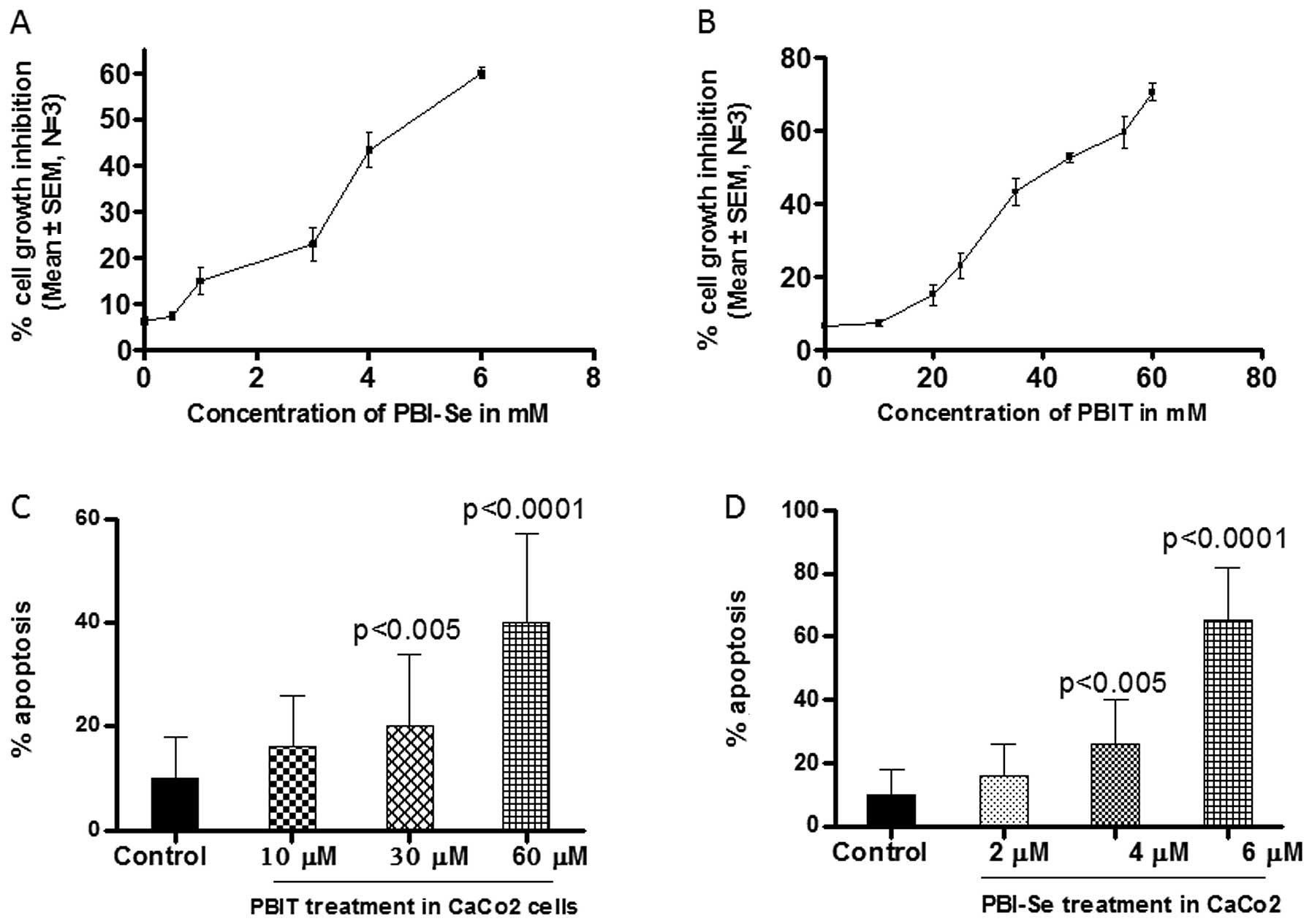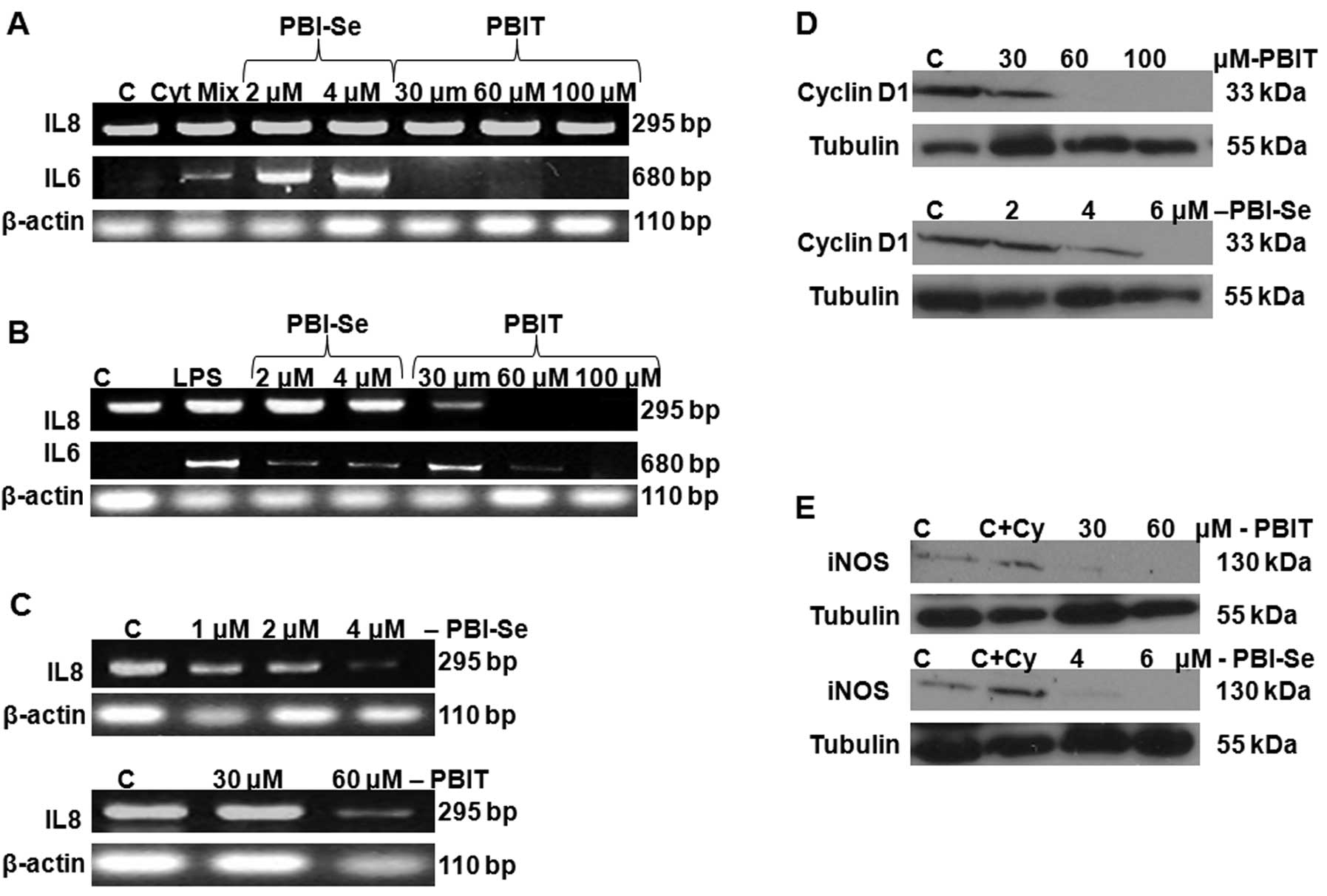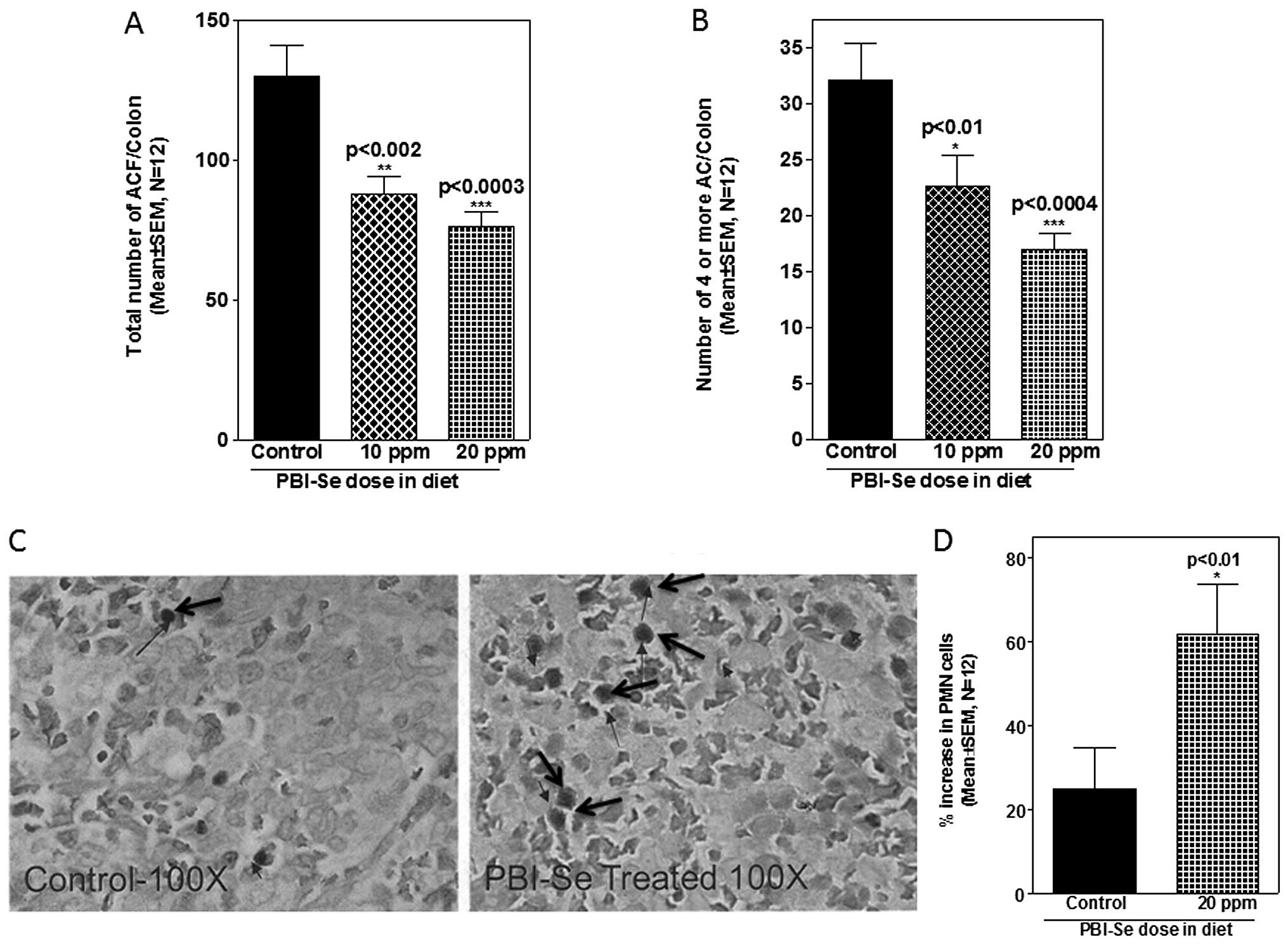|
1
|
American Cancer Society. Colorectal cancer
key statistics. Available at: http://www.cancer.org/Cancer/ColonandRectumCancer/DetailedGuidecolorectal-cancer-key-statistics.
|
|
2
|
Jackson JR, Seed MP, Kircher CH,
Willoughby DA and Winkler JD: The codependence of angiogenesis and
chronic inflammation. FASEB J. 11:457–465. 1997.PubMed/NCBI
|
|
3
|
Phoa N and Epe B: Influence of nitric
oxide on the generation and repair of oxidative DNA damage in
mammalian cells. Carcinogenesis. 23:469–475. 2002. View Article : Google Scholar : PubMed/NCBI
|
|
4
|
Jaiswal M, LaRusso NF, Burgart LJ and
Gores GJ: Inflammatory cytokines induce DNA damage and inhibit DNA
repair in cholangiocarcinoma cells by a nitric oxide-dependent
mechanism. Cancer Res. 60:184–190. 2000.PubMed/NCBI
|
|
5
|
Moore MA: Cytokine and chemokine networks
influencing stem cell proliferation, differentiation, and marrow
homing. J Cell Biochem. 38:29–38. 2002. View Article : Google Scholar : PubMed/NCBI
|
|
6
|
Nakajima N, Kuwayama H, Ito Y, Iwasaki A
and Arakawa Y: Helicobacter pylori, neutrophils,
interleukins, and gastric epithelial proliferation. J Clin
Gastroenterol. 25:S198–S202. 1997. View Article : Google Scholar
|
|
7
|
Eberhart CE, Coffey RJ, Radhika A,
Giardiello FM, Ferrenbach S and DuBois RN: Up-regulation of
cyclooxygenase 2 gene expression in human colorectal adenomas and
adenocarcinomas. Gastroenterology. 107:1183–1188. 1994.PubMed/NCBI
|
|
8
|
Rhodes JM and Campbell BJ: Inflammation
and colorectal cancer: IBD-associated and sporadic cancer compared.
Trends Mol Med. 8:10–16. 2002. View Article : Google Scholar : PubMed/NCBI
|
|
9
|
Keshavarzian A, Fusunyan RD, Jacyno M,
Winship D, MacDermott RP and Sanderson IR: Increased interleukin-8
(IL-8) in rectal dialysate from patients with ulcerative colitis:
evidence for a biological role for IL-8 in inflammation of the
colon. Am J Gastroenterol. 94:704–712. 1999. View Article : Google Scholar : PubMed/NCBI
|
|
10
|
Nusrat A, Sitaraman SV and Neish A:
Interaction of bacteria and bacterial toxins with intestinal
epithelial cells. Curr Gastroenterol Rep. 3:392–398. 2001.
View Article : Google Scholar : PubMed/NCBI
|
|
11
|
Weiss HA and Forman D: Aspirin,
non-steroidal anti-inflammatory drugs and protection from
colorectal cancer: a review of the epidemiological evidence. Scand
J Gastroenterol. 220:137–141. 1996. View Article : Google Scholar : PubMed/NCBI
|
|
12
|
Jenkins DC, Charles IG, Thomsen LL, et al:
Roles of nitric oxide in tumour growth. Proc Natl Acad Sci USA.
92:4392–4396. 1995. View Article : Google Scholar : PubMed/NCBI
|
|
13
|
Ambs S, Merriam WG, Bennett WP, et al:
Frequent nitric oxide synthase-2 expression in human colon
adenomas: implication for tumour angiogenesis and colon cancer
progression. Cancer Res. 58:334–341. 1998.PubMed/NCBI
|
|
14
|
Jobin C, Haskill S, Mayer L, Panja A and
Sartor RB: Evidence for altered regulation of I kappa B alpha
degradation in human colonic cells. J Immunol. 158:226–234.
1997.PubMed/NCBI
|
|
15
|
Knowles RG and Moncada S: Nitric oxide
synthases in mammals. Biochem J. 298:249–258. 1994.PubMed/NCBI
|
|
16
|
Forstermann U, Gath I, Schwarz P, Closs EI
and Kleinert H: Isoforms of nitric oxide synthase. Properties,
cellular distribution and expressional control. Biochem Pharmacol.
50:1321–1332. 1995. View Article : Google Scholar : PubMed/NCBI
|
|
17
|
Pana MH and Ho CT: Chemopreventive effects
of natural dietary compounds on cancer development. Chem Soc Rev.
37:2558–2574. 2008. View
Article : Google Scholar : PubMed/NCBI
|
|
18
|
Rao CV, Kawamori T, Hamid R and Reddy BS:
Chemoprevention of colonic aberrant crypt foci by an inducible
nitric oxide synthase-selective inhibitor. Carcinogenesis.
2:641–644. 1999.PubMed/NCBI
|
|
19
|
Briske-Anderson MJ, Finley JW and Newman
SM: The influence of culture time and passage number on the
morphological and physiological development of CaCo2 cells. Proc
Soc Exp Biol Med. 214:248–257. 1997. View Article : Google Scholar : PubMed/NCBI
|
|
20
|
Huang Y, Li N, Liboni K and Neu J:
Glutamine decreases lipopolysaccharide-induced IL-8 production in
Caco-2 cells through a non-NF-kappaB p50 mechanism. Cytokine.
22:77–83. 2003. View Article : Google Scholar : PubMed/NCBI
|
|
21
|
Chittezhath M, Deep G, Singh RP, Agarwal C
and Agarwal R: Silibinin inhibits cytokine-induced STATs, MAPKs,
NF-κB and AP-1 activation, and down-regulates HIF-1α and iNOS in
human lung carcinoma A549 cells. Mol Cancer Ther. 7:1817–1826.
2008.
|
|
22
|
Bird RP: Observation and quantification of
aberrant crypts in the murine colon treated with a colon
carcinogen: preliminary findings. Cancer Lett. 37:147–151. 1987.
View Article : Google Scholar : PubMed/NCBI
|
|
23
|
Janakiram NB, Mohammed A, Zhang Y, Choi
CI, Woodward C, Collin P, Steele VE and Rao CV: Chemopreventive
effects of Frondanol A5, a Cucumaria frondosa extract,
against rat colon carcinogenesis and inhibition of human colon
cancer cell growth. Cancer Prev Res. 3:82–91. 2010.PubMed/NCBI
|
|
24
|
Arthur JR, McKenzie RC and Beckett GJ:
Selenium in the immune system. J Nutr. 133:S1457–S1459. 2003.
|
|
25
|
Chung CY, Madhunapantula SV, Desai D, Amin
S and Robertson GP: Melanoma prevention using topical PBI-Se.
Cancer Prev Res. 4:935–948. 2011. View Article : Google Scholar : PubMed/NCBI
|
|
26
|
Vermeulen K, Van Bockstaele DR and
Berneman ZN: The cell cycle: a review of regulation, deregulation
and therapeutic targets in cancer. Cell Prolif. 36:131–149. 2003.
View Article : Google Scholar : PubMed/NCBI
|
|
27
|
Fusunyan RD, Quinn JJ, Fujimoto M,
MacDermott RP and Sanderson IR: Butyrate switches the pattern of
chemokine secretion by intestinal epithelial cells through histone
acetylation. Mol Med. 5:631–640. 1999.PubMed/NCBI
|
|
28
|
Ogle CK, Guo XL, Hasselgren PO, Ogle JD
and Alexander JW: The gut as a source of inflammatory cytokines
after stimulation with endotoxin. Eur J Surg. 163:45–51.
1997.PubMed/NCBI
|
|
29
|
Haller D, Bode C, Hammes WP, Pfeifer AMA,
Schiffrin EJ and Blum S: Non-pathogenic bacteria elicit a
differential cytokine response by intestinal epithelial
cell/leucocyte co-cultures. Gut. 47:79–87. 2000. View Article : Google Scholar : PubMed/NCBI
|
|
30
|
Kibriya MG, Jasmine F, Argos M, Verret WJ,
Rakibuz-Zaman M, Ahmed A, Parvez F and Ahsan H: Changes in gene
expression profiles in response to selenium supplementation among
individuals with arsenic-induced pre-malignant skin lesions.
Toxicol Lett. 169:162–176. 2007. View Article : Google Scholar : PubMed/NCBI
|
|
31
|
Terui Y, Ikeda M, Tomizuka H, et al:
Identification of a novel apoptosis-inducing factor derived from
leukemic cells: endothelial interleukin-8, but not
monocyte-derived, induces apoptosis in leukemic cells. Biochem
Biophys Res Commun. 243:407–411. 1998. View Article : Google Scholar
|
|
32
|
Terui Y, Ikeda M, Tomizuka H, et al:
Activated endothelial cells induce apoptosis in leukemic cells by
endothelial interleukin-8. Blood. 92:2672–2680. 1998.PubMed/NCBI
|
|
33
|
Hoffmann E, Dittrich-Breiholz O, Holtmann
H and Kracht M: Multiple control of interleukin-8 gene expression.
J Leukoc Biol. 72:847–855. 2002.PubMed/NCBI
|
|
34
|
Garat C and Arend WP: Intracellular IL-1Ra
type 1 inhibits IL-1-induced IL-6 and IL-8 production in Caco-2
intestinal epithelial cells through inhibition of p38
mitogen-activated protein kinase and NF-kappaB pathways. Cytokine.
23:31–40. 2003. View Article : Google Scholar
|
|
35
|
Lee Li-F, Hellendall RP, Wang Y, Stephen
Haskill J, Mukaida N, Matsushima K and Ting JP: IL-8 reduced
tumorigenicity of human ovarian cancer in vivo due to neutrophil
infiltration. J Immunol. 164:2769–2775. 2000. View Article : Google Scholar : PubMed/NCBI
|
|
36
|
Molica S, Vitelli G, Levato D, Levato L,
Datillo A and Gandolfo GM: Clinico-biological implications of
increased serum levels of interleukin −8 in B cell chronic
lymphocytic leukemia. Haematologica. 84:208–211. 1999.PubMed/NCBI
|
|
37
|
Gartner R, Albrich W and Angstwurm MW: The
effect of a selenium supplementation on the outcome of patients
with severe systemic inflammation, burn, and trauma. Biofactors.
14:199–204. 2001. View Article : Google Scholar : PubMed/NCBI
|
|
38
|
Murata Y, Ishiguro Y, Itoh J, Munakata A
and Yoshida Y: The role of pro-inflammatory and immunoregulatory
cytokines in the pathogenesis of ulcerative colitis. Gastroenterol
Clin North Am J. 30:56–60. 1995.
|
|
39
|
Combs GF Jr and Gray WP: Chemopreventive
agents: selenium. Pharmacol Ther. 79:179–192. 1998. View Article : Google Scholar : PubMed/NCBI
|
|
40
|
Russo MW, Murray SC, Wurzelmann JI,
Woosley JT and Sandler RS: Plasma selenium levels and the risk of
colorectal adenomas. Nutr Cancer. 28:125–129. 1997. View Article : Google Scholar : PubMed/NCBI
|
|
41
|
Patterson BH and Levander OA: Naturally
occurring selenium compounds in cancer chemoprevention trials: a
workshop summary. Cancer Epidemiol Biomarkers Prev. 6:63–69.
1997.PubMed/NCBI
|
|
42
|
Knekt P, Marniemi J, Teppo L, Heliovaara M
and Aromaa A: Is low selenium status a risk factor for lung cancer?
Am J Epidemiol. 148:975–982. 1998. View Article : Google Scholar : PubMed/NCBI
|
|
43
|
Fleet JC: Dietary selenium repletion may
reduce cancer incidence in people at high risk who live in areas
with low soil selenium. Nutr Rev. 55:277–279. 1997. View Article : Google Scholar : PubMed/NCBI
|
|
44
|
Shamberger RJ: The genotoxicity of
selenium. Mutat Res. 154:28–48. 1985.
|
|
45
|
Young KL and Lee PN: Intervention studies
on cancer. Eur J Cancer Prev. 8:91–103. 1999. View Article : Google Scholar
|
|
46
|
Burguera JL, Burguera M, Gallignani M,
Alarcon OM and Burgueera JA: Blood serum selenium in the province
of Merida, Venezuela, related to sex, cancer incidence and soil
selenium content. J Trace Elem Electrolytes Health Dis. 4:73–77.
1990.PubMed/NCBI
|
|
47
|
Combs GF Jr, Clark LC and Turnbull BW:
Reduction of cancer risk with an oral supplement of selenium.
Biomed Environ Sci. 10:227–234. 1997.PubMed/NCBI
|
|
48
|
Clark LC, Combs GF Jr, Turnbull BW, et al:
Effects of selenium supplementation for cancer prevention in
patients with carcinoma of the skin. A randomized controlled trial.
JAMA. 276:1957–1963. 1996. View Article : Google Scholar
|
|
49
|
Combs GF Jr, Clark LC and Turnbull BW: An
analysis of cancer prevention by selenium. Biofactors. 14:153–159.
2001. View Article : Google Scholar : PubMed/NCBI
|
|
50
|
Combs GF Jr: Food system-based approaches
to improving micronutrient nutrition: the case for selenium.
Biofactors. 12:39–43. 2000. View Article : Google Scholar : PubMed/NCBI
|
|
51
|
Zimmerman MB and Kohrle J: The impact of
iron and selenium deficiencies on iodine and thyroid metabolism:
biochemistry and relevance to public health. Thyroid. 12:867–878.
2002. View Article : Google Scholar : PubMed/NCBI
|
|
52
|
Ryan-Harshman M and Aldoori W: The
relevance of selenium to immunity, cancer and
infectious/inflammatory diseases. Can J Diet Pract Res. 66:98–102.
2005. View Article : Google Scholar : PubMed/NCBI
|
|
53
|
Wood SM, Beckham C, Yosioka A, Darban H
and Watson RR: Beta-carotene and selenium supplementation enhances
immune response in aged humans. Integr Med. 2:85–92. 2000.
View Article : Google Scholar : PubMed/NCBI
|
|
54
|
Baum MK, Miguez-Burbano MJ, Campa A and
Shor-Posner G: Selenium and interleukins in persons infected with
human immunodeficiency virus type 1. J Infect Dis. 182:S69–S73.
2000. View
Article : Google Scholar : PubMed/NCBI
|
|
55
|
Lippman SM, Klein EA, Goodman PJ, et al:
Effect of selenium and vitamin E on risk of prostate cancer and
other cancers: the Selenium and Vitamin E Cancer Prevention Trial
(SELECT). JAMA. 301:39–51. 2009. View Article : Google Scholar : PubMed/NCBI
|
|
56
|
Whanger PD: Selenium and its relationship
to cancer: an update. Br J Nutr. 91:11–28. 2004. View Article : Google Scholar : PubMed/NCBI
|













